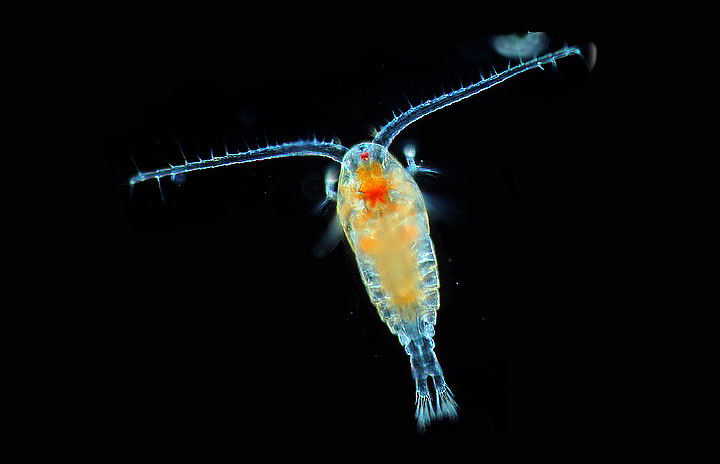

Every night, under the cover of darkness, countless small sea creatures swim from the ocean depths to feed near the surface, then descend out of sight again before daybreak. This vast animal migration—a critical part of Earth’s carbon cycle—has been observed for the first time on a global scale thanks to a space-based laser.
The phenomenon is known as diel vertical migration (DVM). Small sea creatures—from copepods (photo below) to squid to krill—swim up from the deep at night to feed on phytoplankton, then return to the depths just before sunrise. The principal reason for this migration is for some marine creatures to avoid visual predators that would consume them near the surface in daylight.
This natural daily movement has been observed from ships for decades, though in limited areas and times. It is considered the largest migration on Earth by total number of animals. Now researchers have observed it for a decade at the scale of entire gyres and basins of the ocean, thanks to the Cloud-Aerosol Lidar and Infrared Pathfinder Satellite Observations (CALIPSO) satellite. Launched in 2006 by NASA and the Centre National d'Etudes Spatiales, CALIPSO was built to study phenomena in the atmosphere such as clouds, dust, pollution, and volcanic ash. But the satellite’s laser also can penetrate the upper 20 meters of the ocean, so if migrating animals reach this layer, CALIPSO can see them.

“This is the latest study to demonstrate something that came as a surprise to many: that lidars have the sensitivity to provide scientifically useful ocean measurements from space,” said Chris Hostetler, a scientist at NASA's Langley Research Center and co-author of the study. “I think we are just scratching the surface of exciting new ocean science that can be accomplished with lidar.” The results were published in November 2019 in the journal Nature.
The map at the top of this page shows changes in backscattering of light in the ocean from day to night; that is, the change in the intensity of the reflections of laser pulses back to the CALIPSO satellite. Scientists examined data from the day and night passes of the satellite and noted the difference in the amount of backscattering. Areas colored red or orange had the greatest difference in light scattering, a signal that indicates significant numbers of migrating marine creatures in those areas.
“What the lidar allowed us to do is sample these migrating animals on a global scale every 16 days for 10 years,” said Michael Behrenfeld, the lead author of the study and a biological oceanographer at Oregon State University. “We’ve never had anywhere near that kind of global coverage to allow us to look at the behavior, distribution, and abundance of these animals. ”
The cumulative effect of these vertically migrating creatures is significant for Earth’s climate. By day, phytoplankton photosynthesize and absorb significant amounts of carbon dioxide from the atmosphere. Animals that undergo DVM come up and feed on phytoplankton, effectively taking the phytoplankton and their carbon back to depth with them. Much of this carbon is then defecated, where it sinks and effectively becomes trapped deep in the ocean and out of the atmosphere.
That map above shows the distribution of vertical migrators in the world’s oceans, with brighter colors indicating greater abundance. In looking for patterns across the study period (2008-2017), the researchers found that while there are fewer vertically migrating animals in the lower-nutrient and clearer waters of tropical and subtropical ocean regions, they make up a much greater fraction of the total animal population in these regions. In murkier and more nutrient-rich regions (mostly higher latitudes), the abundance of animals that undergo DVM is higher, but they also represent a smaller fraction of the total animal population because more animals stay near the surface by day and night.
The researchers also observed long-term changes in the populations of migrating animals, likely driven by climate variations. CALIPSO data revealed an increase in migrating animal biomass in the subtropical waters of the North and South Pacific and the South Indian oceans. In the tropical regions and North Atlantic, biomass decreased. In all but the tropical Atlantic regions, these changes correlated with changes in phytoplankton abundance.
“The new data give us an opportunity to combine satellite observations with the models and do a better job quantifying the impact of this enormous animal migration on Earth’s carbon cycle,” said Behrenfeld. “What the climate modelers haven’t had is a global dataset to calibrate these models with, to tell them where these migrators are most important, where they are most abundant, and how they change over time.”
NASA Earth Observatory images by Joshua Stevens, using data from Behrenfeld, M. J., et al. (2019). Photo copyright Proyecto Agua, via Encyclopedia of Life. Story by Joseph Atkinson, NASA Langley Research Center, with Michael Carlowicz.